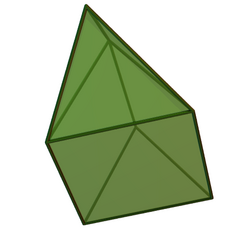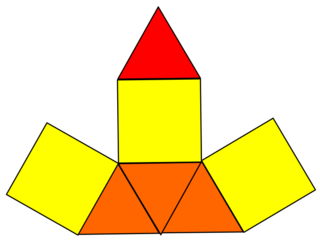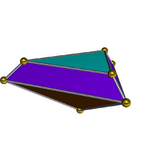Elongated triangular pyramid
| Elongated triangular pyramid | |
|---|---|
 | |
| Type | Johnson J6 – J7 – J8 |
| Faces | 1+3 triangles 3 squares |
| Edges | 12 |
| Vertices | 7 |
| Vertex configuration | 1(33) 3(3.42) 3(32.42) |
| Symmetry group | C3v, [3], (*33) |
| Rotation group | C3, [3]+, (33) |
| Dual polyhedron | self |
| Properties | convex |
| Net | |
 | |
File:Tetraedro elongado 3D.stl
In geometry, the elongated triangular pyramid is one of the Johnson solids (J7). As the name suggests, it can be constructed by elongating a tetrahedron by attaching a triangular prism to its base. Like any elongated pyramid, the resulting solid is topologically (but not geometrically) self-dual.
A Johnson solid is one of 92 strictly convex polyhedra that is composed of regular polygon faces but are not uniform polyhedra (that is, they are not Platonic solids, Archimedean solids, prisms, or antiprisms). They were named by Norman Johnson, who first listed these polyhedra in 1966.[1]
Formulae
The following formulae for volume and surface area can be used if all faces are regular, with edge length a:[2]
- [math]\displaystyle{ V=\left(\frac{1}{12}\left(\sqrt{2}+3\sqrt{3}\right)\right)a^3\approx0.550864...a^3 }[/math]
- [math]\displaystyle{ A=\left(3+\sqrt{3}\right)a^2\approx4.73205...a^2 }[/math]
- [math]\displaystyle{ H = a\cdot \left( 1 + \frac{\sqrt{6}}{3}\right) \approx a\cdot 1.816496581 }[/math]
If the edges are not the same length, use the individual formulae for the tetrahedron and triangular prism separately, and add the results together.
Dual polyhedron
Topologically, the elongated triangular pyramid is its own dual. Geometrically, the dual has seven irregular faces: one equilateral triangle, three isosceles triangles and three isosceles trapezoids.
| Dual elongated triangular pyramid | Net of dual |
|---|---|

|

|
Related polyhedra and honeycombs
The elongated triangular pyramid can form a tessellation of space with square pyramids and/or octahedra.[4]
References
- ↑ Johnson, Norman W. (1966), "Convex polyhedra with regular faces", Canadian Journal of Mathematics 18: 169–200, doi:10.4153/cjm-1966-021-8.
- ↑ Stephen Wolfram, "Elongated triangular pyramid" from Wolfram Alpha. Retrieved July 21, 2010.
- ↑ Sapiña, R.. "Area and volume of the Johnson solid J7" (in es). Problemas y Ecuaciones. ISSN 2659-9899. https://www.problemasyecuaciones.com/geometria3D/volumen/Johnson/J7/calculadora-area-volumen-formulas.html. Retrieved 2020-08-12.
- ↑ "J7 honeycomb". http://woodenpolyhedra.web.fc2.com/J7.html.
External links
 |

